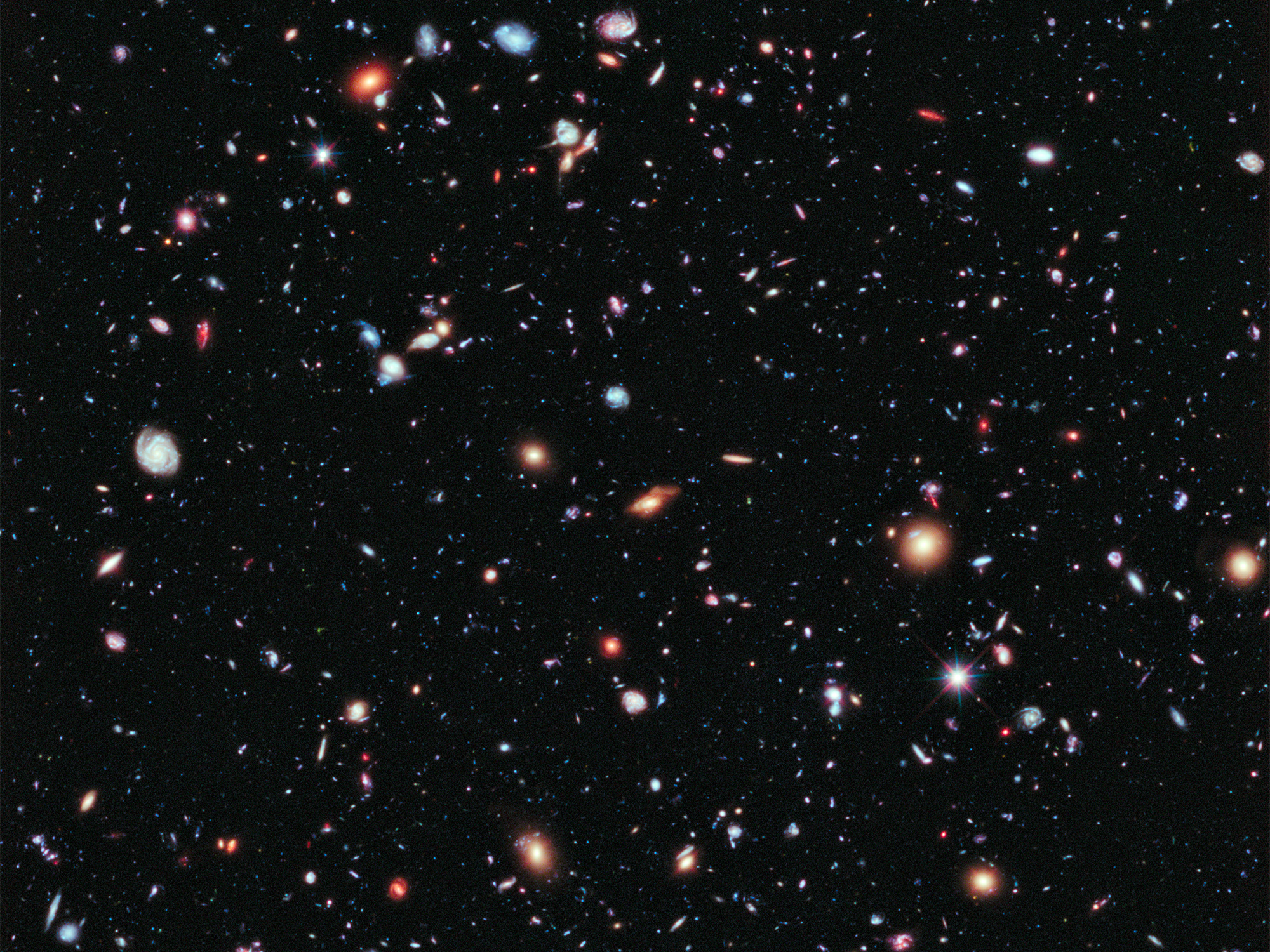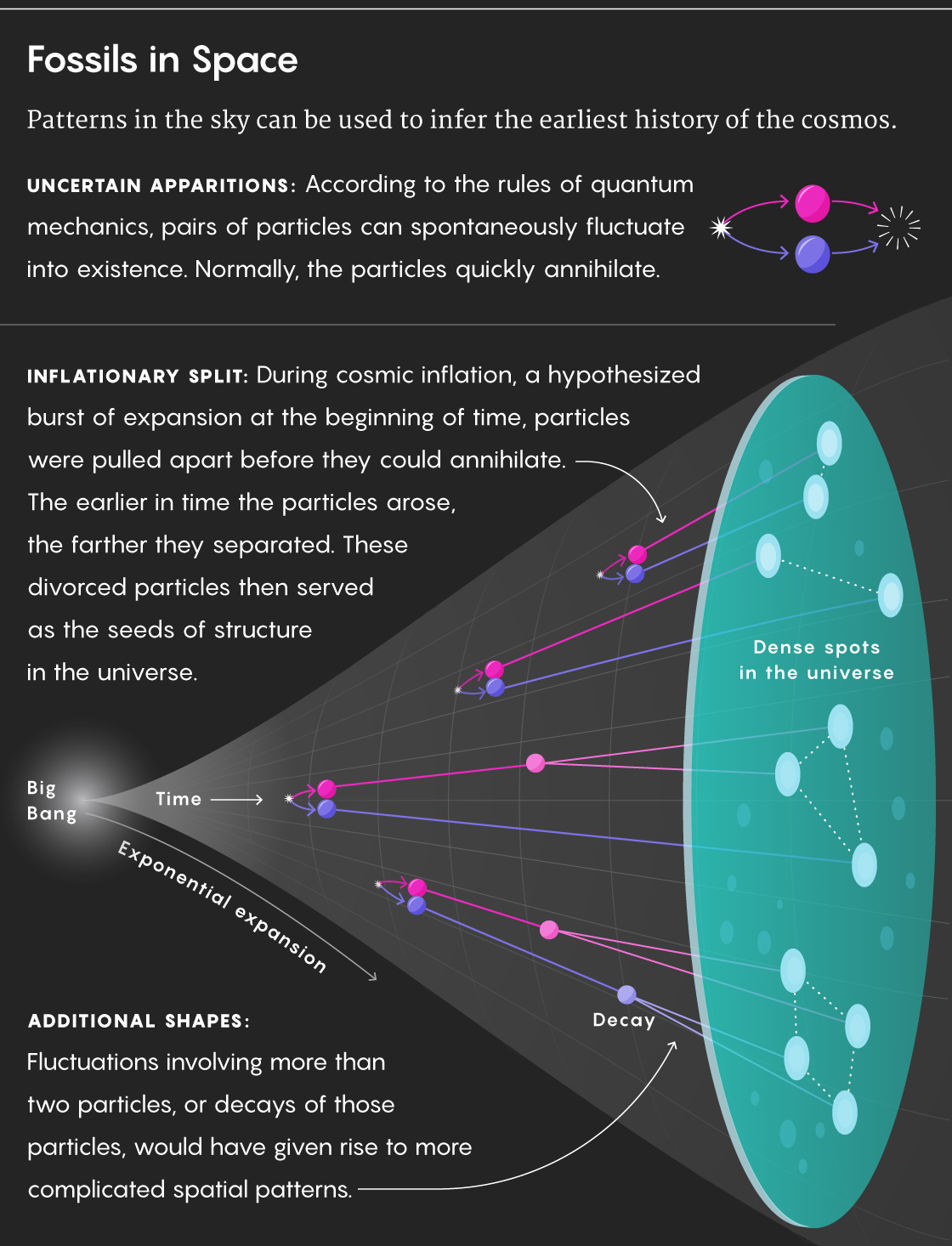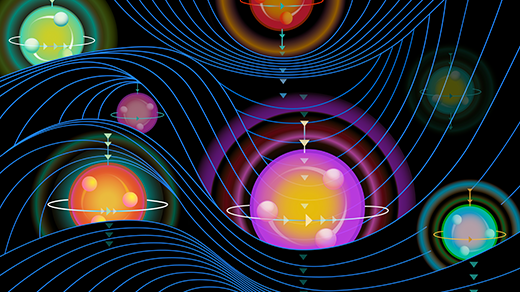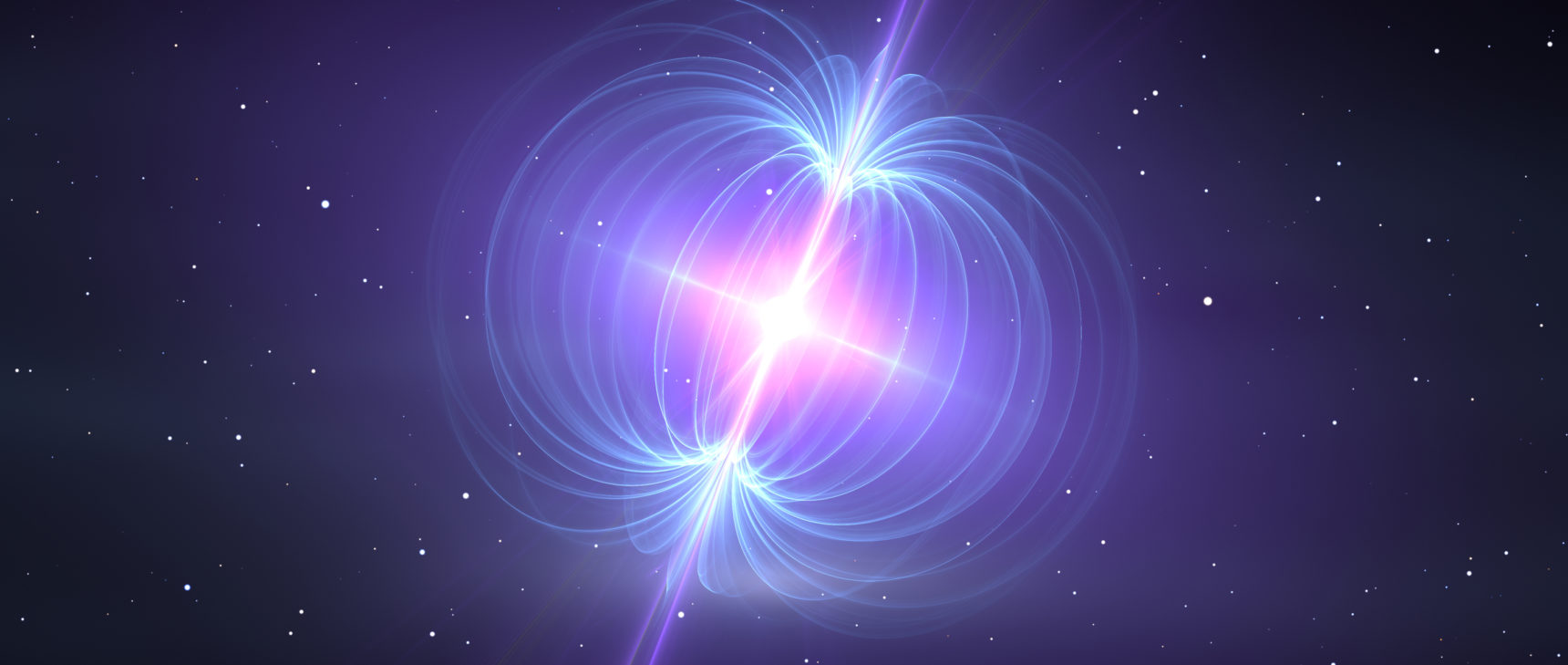Cosmic Triangles Open a Window to the Origin of Time
Introduction
In late August, paleontologists reported (opens a new tab) finding the fossil of a flattened turtle shell that “was possibly trodden on” by a dinosaur, whose footprints spanned the rock layer directly above. The rare discovery of correlated fossils potentially traces two bygone species to the same time and place. “It’s only by doing that that we’re able to reconstruct ancient ecosystems,” one paleontologist told (opens a new tab) The New York Times.
The approach parallels the way cosmologists go about inferring the history of the universe. Like fossils, astronomical objects are not randomly strewn throughout space. Rather, spatial correlations between the positions of objects such as galaxies tell a detailed story of the ancient past. “Paleontologists infer the existence of dinosaurs to give a rational accounting of strange patterns of bones,” said Nima Arkani-Hamed (opens a new tab), a physicist and cosmologist at the Institute for Advanced Study in Princeton, New Jersey. “We look at patterns in space today, and we infer a cosmological history in order to explain them.”
One curious pattern cosmologists have known about for decades is that space is filled with correlated pairs of objects: pairs of hot spots seen in telescopes’ maps of the early universe; pairs of galaxies or of galaxy clusters or superclusters in the universe today; pairs found at all distances apart. You can see these “two-point correlations” by moving a ruler all over a map of the sky. When there’s an object at one end, cosmologists find that this ups the chance that an object also lies at the other end.
The simplest explanation for the correlations traces them to pairs of quantum particles that fluctuated into existence as space exponentially expanded at the start of the Big Bang. Pairs of particles that arose early on subsequently moved the farthest apart, yielding pairs of objects far away from each other in the sky today. Particle pairs that arose later separated less and now form closer-together pairs of objects. Like fossils, the pairwise correlations seen throughout the sky encode the passage of time — in this case, the very beginning of time.
Cosmologists believe that rare quantum fluctuations involving three, four or even more particles should also have occurred during the birth of the universe. These presumably would have yielded more complicated configurations of objects in the sky today: triangular arrangements of galaxies, along with quadrilaterals, pentagons and other shapes. Telescopes haven’t yet spotted these statistically subtle “higher-point” correlations, but finding them would help physicists better understand the first moments after the Big Bang.
Yet theorists have found it challenging even to calculate what the signals would look like — until recently. In the past four years, a small group of researchers has approached the question in a new way. They have found that the form of the correlations follows directly from symmetries and other deep mathematical principles. The most important findings to date were detailed in a paper (opens a new tab) by Arkani-Hamed and three co-authors that took its final form this summer.

This Hubble Space Telescope image contains about 5,500 galaxies in a region of sky a small fraction of the diameter of the full moon. Cosmologists find that galaxies exhibit a nearly scale-invariant two-point pattern; hold a ruler of any length up to the sky, and if there’s a galaxy at one end, this increases the chance of a galaxy also lying at the other end.
NASA; ESA; G. Illingworth, D. Magee, and P. Oesch, University of California, Santa Cruz; R. Bouwens, Leiden University; and the HUDF09 Team)
The physicists employed a strategy known as the bootstrap, a term derived from the phrase “pick yourself up by your own bootstraps” (instead of pushing off of the ground). The approach infers the laws of nature by considering only the mathematical logic and self-consistency of the laws themselves, instead of building on empirical evidence. Using the bootstrap philosophy, the researchers derived and solved a concise mathematical equation that dictates the possible patterns of correlations in the sky that result from different primordial ingredients.
“They’ve found ways of calculating things that just look totally different from the textbook approaches,” said Tom Hartman (opens a new tab), a theoretical physicist at Cornell University who has applied the bootstrap in other contexts.
Eva Silverstein (opens a new tab), a theoretical physicist at Stanford University who wasn’t involved in the research, added that the recent paper by Arkani-Hamed and collaborators is “a really beautiful contribution.” Perhaps the most remarkable aspect of the work, Silverstein and others said, is what it implies about the nature of time. There’s no “time” variable anywhere in the new bootstrapped equation. Yet it predicts cosmological triangles, rectangles and other shapes of all sizes that tell a sensible story of quantum particles arising and evolving at the beginning of time.
This suggests that the temporal version of the cosmological origin story may be an illusion. Time can be seen as an “emergent” dimension, a kind of hologram springing from the universe’s spatial correlations, which themselves seem to come from basic symmetries. In short, the approach has the potential to help explain why time began, and why it might end. As Arkani-Hamed put it, “The thing that we’re bootstrapping is time itself.”
A Map of the Start of Time
In 1980, the cosmologist Alan Guth (opens a new tab), pondering a number of cosmological features, posited that the Big Bang began with a sudden burst of exponential expansion, known as “cosmic inflation.” Two years later, many of the world’s leading cosmologists gathered in Cambridge, England, to iron out the details of the new theory. Over the course of the three-week Nuffield workshop, a group that included Guth, Stephen Hawking, and Martin Rees, the future Astronomer Royal, pieced together (opens a new tab) the effects of a brief inflationary period at the start of time. By the end of the workshop, several attendees had separately calculated that quantum jitter during cosmic inflation could indeed have happened at the right rate and evolved in the right way to yield the universe’s observed density variations.
To understand how, picture the hypothetical energy field that drove cosmic inflation, known as the “inflaton field.” As this field of energy powered the exponential expansion of space, pairs of particles would have spontaneously arisen in the field. (These quantum particles can also be thought of as ripples in the quantum field.) Such pairs pop up in quantum fields all the time, momentarily borrowing energy from the field as allowed by Heisenberg’s uncertainty principle. Normally, the ripples quickly annihilate and disappear, returning the energy. But this couldn’t happen during inflation. As space inflated, the ripples stretched like taffy and were yanked apart, and so they became “frozen” into the field as twin peaks in its density. As the process continued, the peaks formed a nested pattern on all scales.

Lucy Reading-Ikkanda/Quanta Magazine
After inflation ended (a split second after it began), the spatial density variations remained. Studies of the ancient light called the cosmic microwave background have found that the infant universe was dappled with density differences of about one part in 10,000 — not much, but enough. Over the nearly 13.8 billion years since then, gravity has heightened the contrast by pulling matter toward the dense spots: Now, galaxies like the Milky Way and Andromeda are 1 million times denser than the cosmic average. As Guth wrote in his memoir (referring to a giant swath of galaxies rather than the wall in China), “The same Heisenberg uncertainty principle that governs the behavior of electrons and quarks may also be responsible for Andromeda and The Great Wall!”
Then in the 1980s and ’90s, cosmologists started to wonder what other fields or extra mechanisms or ingredients might have existed during cosmic inflation besides the inflaton field, and how these might change the pattern. People knew that the inflaton field must at least have interacted with the gravitational field. Since fields tend to spill into each other quantum mechanically, when a pair of particles materialized in the inflaton field and got dragged apart by cosmic expansion, occasionally one of the pair should have spontaneously morphed into two graviton particles — excitations of the gravitational field. This pair, and the inflaton particle that remained, would have continued to separate, freezing into space and creating a triangular arrangement of energy concentrations. Meanwhile, if a pair of primordial particles fluctuated into existence, and then each particle decayed into two other particles, this would later yield a four-point correlation.
But while telescopes see two-point correlations very clearly, three- and higher-point correlations are expected to be rarer, and thus harder to spot. These signals have so far stayed buried in the noise, though several powerful telescopes coming online in the next decade have a chance of teasing them out.
Cosmology’s fossil hunters look for the signals by taking a map of the cosmos and moving a triangle-shaped template all over it. For each position and orientation of the template, they measure the cosmos’s density at the three corners and multiply the numbers together. If the answer differs from the average cosmic density cubed, this is a three-point correlation. After measuring the strength of three-point correlations for that particular template throughout the sky, they then repeat the process with triangle templates of other sizes and relative side lengths, and with quadrilateral templates and so on. The variation in strength of the cosmological correlations as a function of the different shapes and sizes is called the “correlation function,” and it encodes rich information about the particle dynamics during the birth of the universe.
That’s the idea, anyway. Attempts were made to approximate the form of the three-point correlation function, but trying to actually calculate the dynamics of interacting primordial particles against a background of exponentially expanding space was about as hard as it sounds.
Then in 2002, Juan Maldacena (opens a new tab), a theoretical physicist at the Institute for Advanced Study, successfully calculated (opens a new tab) the patterns of three-point correlations arising from interactions between inflatons and gravitons. Maldacena’s calculation started an industry, as researchers applied his techniques to work out the higher-point signatures of other inflationary models, which posit additional fields and associated particles beyond inflatons and gravitons.
But Maldacena’s brute-force method of calculating the primordial particle dynamics was hard going and conceptually opaque. “Let’s put it this way: It’s quite complicated,” said Gui Pimentel (opens a new tab), a physicist at the University of Amsterdam and a co-author of the new cosmological bootstrap paper.
Simple Symmetry
In March 2014, scientists with the BICEP2 telescope announced that they had detected swirls in the sky imprinted by pairs of gravitons during cosmic inflation. The swirl pattern was quickly determined to come from galactic dust rather than events from the dawn of time, but in the course of the debacle many physicists, including Arkani-Hamed and Maldacena, started thinking anew about inflation.
Combining their expertise, the two physicists realized that they could treat cosmic inflation like an ultrapowerful particle collider. The energy of the inflaton field would have fueled the copious production of pairs of particles, whose interactions and decay would have yielded higher-point correlations similar to the cascades of particles that fly out of collisions at Europe’s Large Hadron Collider.
Ordinarily, this reframing wouldn’t help; particle interactions can proceed in innumerable ways, and the standard method for predicting the likeliest outcomes — essentially, taking a weighted sum of as many possible chains of events as you can write down — is a slog. But particle physicists had recently found shortcuts using the bootstrap. By leveraging symmetries, logical principles and consistency conditions, they could often determine the final answer without ever working through the complicated particle dynamics. The results hinted that the usual picture of particle physics, in which particles move and interact in space and time, might not be the deepest description of what is happening. A major clue came in 2013, when Arkani-Hamed and his student Jaroslav Trnka discovered that the outcomes of certain particle collisions follow very simply from the volume of a geometric shape called the amplituhedron.
With these discoveries in mind, Arkani-Hamed and Maldacena suspected that they could arrive at a simpler understanding of the dynamics during cosmic inflation. They used the fact that, according to inflationary cosmology, the exponentially expanding universe had almost exactly the geometry of “de Sitter space,” a sphere-like space that has 10 symmetries, or ways it can be transformed and still stay the same. Some of these symmetries are familiar and still hold today, like the fact that you can move or turn in any direction and the laws of physics stay the same. De Sitter space also respects dilatation symmetry: When you zoom in or out, all physical quantities stay the same or at most become rescaled by a constant number. Lastly, de Sitter space is symmetric under “special conformal transformations”: When you invert all spatial coordinates, then shift the coordinates by a translation, then invert them again, nothing changes.
The duo found that these 10 symmetries of an inflating universe tightly constrain the cosmological correlations that inflation can produce. Whereas in the usual approach, you would start with a description of inflatons and other particles that might have existed; specify how they might move, interact and morph into one another; and try to work out the spatial pattern that might have frozen into the universe as a result, Arkani-Hamed and Maldacena translated the 10 symmetries of de Sitter space into a concise differential equation dictating the final answer. In a 2015 paper (opens a new tab), they solved the equation in the “squeezed limit” of very narrow triangles and quadrilaterals, but they couldn’t solve it in full.
Daniel Baumann (opens a new tab) and Hayden Lee (opens a new tab), then a professor and graduate student, respectively, at Cambridge University, and Pimentel in Amsterdam soon saw how to extend Arkani-Hamed and Maldacena’s solution to three- and four-point correlation functions for a range of possible primordial fields and associated particles. Arkani-Hamed struck up a collaboration with the young physicists, and the four of them bootstrapped their way further through the math.
They found that a particular four-point correlation function is key, because once they had solved the differential equation dictating this function, they could bootstrap all the others. “They basically showed that symmetries, with just a few extra requirements, are strong enough to tell you the full answer,” said Xingang Chen (opens a new tab), a cosmologist at Harvard University whose own calculations (opens a new tab) about higher-point correlations helped inspire Arkani-Hamed and Maldacena’s 2015 work.



Daniel Baumann, Gui Pimentel and Hayden Lee are collaborators on a recent effort to infer the possible patterns in the sky that could arise from particle dynamics at the beginning of time.
Julian Baumann; Elizaveta Kolesnichenko; Courtesy of Jungmin Lee
One caveat is that the bootstrapped equation assumes weak interactions between primordial fields, while some models of inflation posit stronger dynamics. Arkani-Hamed and company are exploring how to relax the weakness assumption. Already, their equation simplifies many existing calculations in the literature. For instance, Maldacena’s 2002 calculation of the simplest three-point correlation function, which filled dozens of pages, “collapses down to a few lines,” Pimentel said.
So far, the calculations have concerned the spatial patterns that could arise from cosmic inflation. Alternative theories of the birth of the universe would be expected to have different higher-point signatures. In the last five years, there’s been a renewed interest in bounce cosmology, which recasts the Big Bang as a Big Bounce from a previous era. The new symmetry-based approach might be useful for distinguishing between the higher-point correlations of a universe that inflated and one that bounced. “The mechanism would be different; the symmetries are different,” Pimentel said. “They would have a different menu of cosmological correlations.”
Those are additional calculations to pursue with the new mathematical tools. But the researchers are also continuing to explore the math itself. Arkani-Hamed suspects that the bootstrapped equation that he and his collaborators derived may be related to a geometric object, along the lines of the amplituhedron, that encodes the correlations produced during the universe’s birth even more simply and elegantly. What seems clear already is that the new version of the story will not include the variable known as time.
Where Time Comes From
The amplituhedron reconceptualized colliding particles — ostensibly temporal events — in terms of timeless geometry. When it was discovered in 2013, many physicists saw yet another reason to think that time must be emergent — a variable that we perceive and that appears in our coarse-grained description of nature, but which is not written into the ultimate laws of reality.
At the top of the list of reasons for that hunch is the Big Bang.
The Big Bang was when time as we know it sprang forth. Truly understanding that initial moment would seem to require an atemporal perspective. “If there’s anything that asks us to come up with something that replaces the notion of time, it’s these questions about cosmology,” Arkani-Hamed said.
Thus, physicists seek timeless math that generates what looks like a universe evolving in time. The recent research offers glimpses of how that might work.
Physicists start with the 10 symmetries of de Sitter space. For any given set of inflationary ingredients, these symmetries yield a differential equation. The equation’s solutions are the correlation functions — mathematical expressions stating how the strength of correlations of each particular shape varies as a function of size, interior angles and relative side lengths. Importantly, solving the equation to get these expressions requires considering the equation’s singularities: mathematically nonsensical combinations of variables that are equivalent to division by zero.
The equation typically becomes singular, for instance, in the limit where two adjacent sides of a quadrilateral fold toward one another, so that the quadrilateral approaches the shape of a triangle. Yet triangles (that is, three-point correlations) are also allowed solutions to the equation. So the researchers require that the “folded limit” of the four-point correlation function match the three-point correlation function in that limit. This requirement picks out a particular solution as the correct four-point correlation function.
This function happens to oscillate. In practice, that means that when cosmologists hold a quadrilateral-shaped template up to the sky and look for matter surpluses at the four corners, and then do the same thing with templates of progressively narrower quadrilaterals, they should see the strength of the detected four-point signal go up and down.
This oscillation has a temporal interpretation: Pairs of particles that arose in the inflaton field interfered with one another. As they did so, their likelihood of decaying varied as a function of time (and thus distance) between them. This led them to imprint an oscillatory pattern of four-point correlations on the sky. “Since oscillations are synonymous with time evolution, this for me was the clearest instance of the emergence of time,” said Baumann, who is now a professor at the University of Amsterdam.
In this and a number of other examples, time evolution seems to come straight out of symmetries and singularities.
At present, though, the bootstrapped equation remains a rather strange mix of math and physics. The side lengths in the equation have units of momentum, for instance — a physical quantity — and correlation functions relate physical quantities in disparate locations. Arkani-Hamed seeks a simpler, more purely geometric formulation of the math, which, if found, could offer further insights about the possible emergence of time and the principles that underlie it. For the particle interactions described by the amplituhedron, for instance, sensible outcomes are guaranteed by a principle called positivity, which defines the interior volume of the amplituhedron. Positivity may also play a role in the cosmological case.
Another goal is to extend the story from the universe’s beginning to its end. Intriguingly, if current trends continue, the universe will ultimately reach a state in which the 10 de Sitter symmetries will be restored. The restoration might occur trillions of years from now, when every object down to the smallest particle has expanded out of causal contact with every other object, making the universe as good as empty, and perfectly symmetrical under translations, rotations, dilatations and special conformal transformations. What this possible de Sitter end state has to do with the de Sitter-like beginning posited by inflation remains to be worked out.
Recall that an inflating universe would have had almost, but not exactly, the geometry of de Sitter space. In perfect de Sitter space, nothing changes in time; the whole outwardly stretching geometry exists at once. The inflaton field weakly broke this temporal symmetry by slowly dropping in energy over time, initiating change. Baumann sees this as necessary for creating cosmology. “In cosmology by definition we want something that’s evolving in time,” he said. “In de Sitter space, there’s no evolution. It’s interesting that we live very close to that point.” He compared the primordial universe to a system like water or a magnet very near the critical point where it undergoes a phase transition. “We live in a very special place,” he said.
Corrected on October 30, 2019: The original version of this story defined a three-point correlation by reference to the average cosmic density times three. In fact, a three-point correlation comes about when the product of the cosmos’s density at three corners of a triangle differs from the average cosmic density cubed.
This article was reprinted on Wired.com (opens a new tab).




